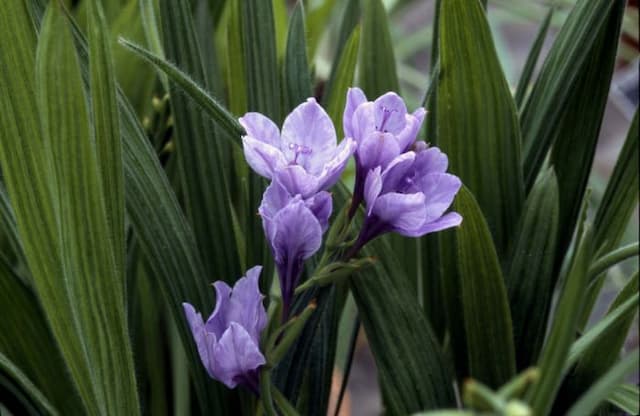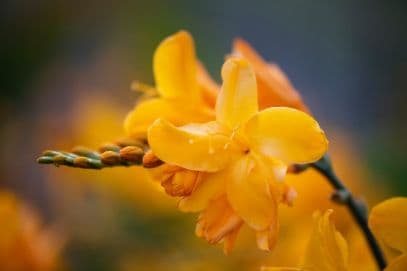Tall Bearded Iris Iris 'Orange Harvest' (TB)

ABOUT
Iris 'Orange Harvest' is a variety of tall bearded iris, known for its distinctively colorful blooms. The plant is characterized by its showy flowers, which have a rich, warm orange hue that stands out in any garden setting. The flowers are typically large and comprise three upright petals, known as standards, and three downward-curving petals, called falls. The falls are often adorned with a beard-like tuft of short hairs in a complementary or contrasting color, which in this case may be a lighter orange or yellow, adding to the visual interest of the bloom. The foliage of Iris 'Orange Harvest' consists of long, sword-shaped green leaves that grow in a fan-like arrangement. These leaves are typically stiff and can give the plant a vertical, structural quality. As with other bearded iris varieties, the leaves emerge from thick, underground stems called rhizomes, which store nutrients and water for the plant. The contrasting deep green of the foliage against the vibrant orange of the bloom creates a striking appearance that is attractive to gardeners and plant enthusiasts alike. In summary, Iris 'Orange Harvest' stands out with its large, warm orange flowers accented by petal beards, set against a backdrop of stiff, sword-like green leaves. The overall appearance is one of bold color and classic iris form, making it a popular choice for gardens where a splash of bright color is desired.
About this plant
 Names
NamesFamily
Iridaceae
Synonyms
Tall Bearded Iris, Bearded Iris
Common names
Iris 'Orange Harvest' (TB)
 Toxicity
ToxicityTo humans
Tall Bearded Iris, including the cultivar 'Orange Harvest', may contain compounds that can be toxic when ingested. Although they are primarily grown for ornamental purposes and are not typically ingested by humans, the rhizomes (the underground stems) are known to contain irisin, iridin, or irisine. If any part of the plant, particularly the rhizomes, is ingested, it may cause stomach pain, nausea, vomiting, and diarrhea. In general, Tall Bearded Iris is considered to have a low toxicity level, but consuming large quantities could lead to more severe digestive upset. As with any plant ingestion, it is wise to seek medical attention if symptoms occur or if there is a suspicion of iris poisoning.
To pets
Tall Bearded Iris can be toxic to pets if ingested. The rhizomes contain the highest concentration of the toxic compounds— which can include irisin, iridin, or irisine. Symptoms of iris poisoning in pets can include gastrointestinal upset such as drooling, vomiting, or diarrhea. In severe cases, ingestion could potentially lead to abdominal pain or lethargy. If a pet ingests part of a Tall Bearded Iris, particularly the rhizomes, it is important to seek veterinary care promptly to manage the symptoms effectively and prevent more serious health issues.
 Characteristics
CharacteristicsLife cycle
Perennials
Foliage type
Deciduous
Color of leaves
Green
Flower color
Orange
Height
2-3 feet (60-90 cm)
Spread
1-2 feet (30-60 cm)
Plant type
Bulb
Hardiness zones
Varies
Native area
Temperate Northern Hemisphere
Benefits
 General Benefits
General Benefits- Attractive Flowers: The Iris 'Orange Harvest' blooms with vibrant orange flowers that can add a stunning pop of color to any garden or landscape.
- Drought Tolerance: Once established, these irises are relatively drought-tolerant, making them suitable for gardens in drier climates or for gardeners seeking low-water plants.
- Low Maintenance: They require minimal care beyond initial planting and occasional watering, making them a convenient choice for busy gardeners.
- Attracts Pollinators: The flowers attract bees and butterflies, which are essential for pollinating gardens and promoting biodiversity.
- Hardiness: This particular variety is resilient and can thrive in a range of soil types and weather conditions, suitable for USDA zones 3-9.
- Seasonal Interest: With their spring to early summer bloom time, they help create seasonal interest in the garden.
- Easy to Divide: Over time, clusters of Iris 'Orange Harvest' can be easily divided to propagate more plants or to share with other gardeners.
- Deer Resistant: They are typically resistant to deer, which can be an important consideration for gardeners in areas with a prevalent deer population.
 Medical Properties
Medical PropertiesThis plant is not used for medical purposes.
 Air-purifying Qualities
Air-purifying QualitiesThis plant is not specifically known for air purifying qualities.
 Other Uses
Other Uses- Photography Subject: The contrasting orange blooms of the Iris 'Orange Harvest' make it an attractive subject for photographers, especially those interested in nature and macro photography.
- Fabric Dyeing: Petals of the Iris can be used to create a natural dye for fabrics, imparting a soft, yellowish-orange hue to textiles.
- Artistic Inspiration: Artists may find inspiration in the unique color and form of the Iris 'Orange Harvest' for paintings, drawings, and other artistic creations.
- Perfumery: While not commonly used for commercial fragrances, the scent of the Iris 'Orange Harvest' can be used in homemade perfumes or potpourri mixes.
- Culinary Garnish: The edible petals of Iris 'Orange Harvest' can be used as a colorful garnish for salads and desserts, though they are not commonly eaten.
- Eco-Friendly Confetti: Dried petals of the Iris can be used as biodegradable confetti for garden parties and weddings.
- Feng Shui: According to Feng Shui, placing Irises in certain areas of the home or garden is believed to bring positive energy and improve the ambiance.
- Pressed Flower Crafts: The blooms of the Iris 'Orange Harvest' can be pressed and used in crafting, such as in homemade cards, bookmarks, or framed botanical art.
- Floral Water Colors: Crushed petals of the Iris can be used to tint water for decorative purposes in vases or bowls.
- Garden Design: Irises are often used in garden design for their height and striking color, offering a vertical element and warm tones in landscape arrangements.
Interesting Facts
 Feng Shui
Feng ShuiThe Iris is not commonly used in Feng Shui practice.
 Zodiac Sign Compitability
Zodiac Sign CompitabilityThe Iris is not used in astrology practice.
 Plant Symbolism
Plant Symbolism- Hope: The Iris often symbolizes hope, representing the expectation of positive outcomes and perseverance through challenging times.
- Wisdom: In some cultural contexts, Irises are seen as a symbol of wisdom and valued for their perceived ability to impart knowledge and insight.
- Faith: The flower is also a symbol of faith, with its intricate design and upright stature conveying a sense of trust and belief.
- Courage: The Iris can represent courage, especially in the face of adversity, signaling bravery and strength.
- Royalty: Due to its regal appearance, the Iris sometimes signifies royalty and majesty, often associated with rulers and sovereignty.
- Purity: The flower's clear colors and graceful form can symbolize purity, often used in contexts that denote cleanliness and innocence.
 Water
WaterThe Tall Bearded Iris, commonly known as 'Orange Harvest', should be watered deeply once a week, providing about one gallon of water per plant to ensure adequate moisture reaches the roots. During hot and dry spells, increase watering frequency to twice per week. It's important to avoid overwatering, which can lead to root rot, so allow the soil to dry slightly between waterings. Always water at the base of the plant to keep the foliage dry and prevent disease.
 Light
LightTall Bearded Iris, including 'Orange Harvest', thrives in full sun conditions, receiving at least six hours of direct sunlight each day. The best spot for this iris is in a location where it can enjoy the morning sun, which is less intense, while still benefitting from the afternoon light. Partial shade is tolerable, but may result in fewer blooms.
 Temperature
Temperature'Orange Harvest' Tall Bearded Iris prefers temperatures ranging from 35 to 85 degrees Fahrenheit. It can survive minimum temperatures down to about 20 degrees Fahrenheit and maximum temperatures up to 90 degrees Fahrenheit. The ideal growing conditions are during the spring and fall when temperatures are moderate and consistent.
 Pruning
PruningPrune 'Orange Harvest' Tall Bearded Iris by removing spent flower stalks at their base to promote healthy growth and prevent seed formation, which can sap energy from the plant. After blooming, cut back any damaged or diseased foliage, and trim all leaves to about 6 inches above the ground in the fall to tidy the plant and reduce overwintering pests and diseases. The best time for major pruning is after flowering and before the onset of winter.
 Cleaning
CleaningAs needed
 Soil
SoilFor Tall Bearded Iris 'Orange Harvest', a well-drained soil mix is essential, ideally with good loamy texture and slight acidity to neutral pH; a pH of 6.5 to 7.0 is best. Amend garden soil with compost and coarse sand to improve drainage.
 Repotting
RepottingTall Bearded Iris 'Orange Harvest' generally does not need frequent repotting; divide rhizomes every 3-5 years to prevent overcrowding and rejuvenate growth.
 Humidity & Misting
Humidity & MistingTall Bearded Iris 'Orange Harvest' tolerates a wide range of humidity levels and generally does not require high humidity; average outdoor conditions are suitable.
 Suitable locations
Suitable locationsIndoor
For Tall Bearded Iris, provide bright light and good airflow.
Outdoor
Plant in sunny spot with well-drained soil for Tall Bearded Iris.
Hardiness zone
3-9 USDA
 Life cycle
Life cycleIris 'Orange Harvest' (Tall Bearded Iris) begins its life cycle with seed germination, given the right conditions of moisture and temperature. The sprouted seeds then develop into small plants with a rosette of leaves at their base, initiating the vegetative growth stage. As the plant matures, it forms thick, underground stems called rhizomes, which store energy for next season's growth. During spring, the Iris 'Orange Harvest' enters the reproductive stage, where it produces tall, sturdy stems that bear vibrant orange blooms renowned for their ornamental beauty. After flowering, seed pods may form, which eventually dry and release seeds to start the next generation. The plant then enters a period of dormancy in winter, where above-ground foliage dies back, and the rhizome survives underground until the next growing season.
 Propogation
PropogationPropogation time
Late Summer
Propogation: The Tall Bearded Iris 'Orange Harvest' is most commonly propagated through division, a process which is ideally undertaken in late summer after the blooms have faded and the plant has gone dormant. To propagate by division, one should carefully dig up the Iris clump and gently separate the rhizomes, which are the horizontal stem structures from which the plant grows. Each section should have at least one fan of leaves and a portion of the roots. Trimming the leaves to a third of their original height and the roots to about four to six inches (10-15 centimeters) can help the plant establish itself more easily when replanted. The divisions should then be replanted in well-draining soil, with the top of the rhizome exposed to the sunlight. It's essential to water them in well after planting and maintain even moisture without overwatering, as Irises do not tolerate soggy conditions. This method allows for relatively rapid increase of one's Iris collection and ensures that the new plants are identical to the parent.









